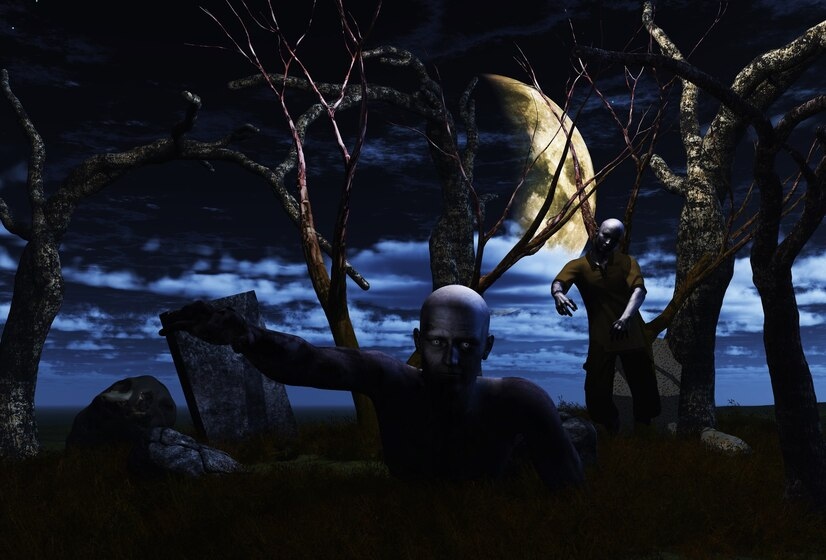BLOG
Vesperhex: Exploring the Enigmatic World of Dark Aesthetics

In a world brimming with vibrant colors and luminous expressions, an intriguing artistic subculture quietly thrives—dark aesthetics. Captivating and enigmatic, this visual style has carved its niche among the Vesperhex community, drawing in those who are drawn to the mysterious allure of shadowy palettes and introspective themes. This post will unravel the secrets of dark aesthetics, exploring its origins, influences, and the unique charm it holds for the Vesperhex audience.
From the somber tones that dominate its palette to the deeper meanings hidden within its art forms, dark aesthetics offer a rich tapestry waiting to be explored. Whether you’re a seasoned Vesperhex enthusiast or a curious newcomer, get ready to venture into a world where shadows speak louder than words, and every piece of art tells a story waiting to be deciphered.
The Origins of Dark Aesthetics
Dark aesthetics trace their roots back to various cultural and historical influences that have shaped their evolution over time. One significant influence is the Gothic movement of the late Middle Ages, which emphasized the beauty in darkness and the sublime. This era’s architecture, literature, and art celebrated intricate details and melancholic themes, laying the groundwork for dark aesthetics as we know them today.
Another pivotal moment in the development of dark aesthetics was during the Romantic period of the 18th and 19th centuries. Romanticism celebrated emotion and individualism, often exploring themes of nature’s beauty and power, as well as the darker aspects of the human experience. This movement’s fascination with the mysterious and unknown further contributed to the allure of dark aesthetics.
In the 20th century, the rise of subcultures such as goth and punk introduced new elements to dark aesthetics, incorporating music, fashion, and visual art. These subcultures embraced the unconventional and defied societal norms, creating an environment where dark aesthetics could thrive and evolve.
Key Characteristics of Dark Aesthetics
Dark aesthetics are characterized by their moody and atmospheric visuals, often evoking a sense of mystery and introspection. These aesthetics typically feature a limited color palette, focusing on deep, rich hues like black, charcoal, and midnight blue. These colors are often contrasted with subtle accents of white, silver, or gold, creating striking visual compositions.
Texture plays a significant role in dark aesthetics, with an emphasis on materials that convey a sense of depth and complexity. Velvet, lace, and leather are common elements, adding a tactile dimension to the visual experience. These textures complement the intricate details often found in dark aesthetic works, drawing the viewer into a world of shadows and secrets.
Symbolism is another crucial aspect of dark aesthetics, with many artworks incorporating motifs that evoke themes of death, rebirth, and transformation. Skulls, ravens, and trees are just a few examples of the symbols that populate this enigmatic world, each carrying its own unique meaning and significance.
The Appeal of Dark Aesthetics
For many members of the Vesperhex community, dark aesthetics offer a means of self-expression and exploration. This artistic style allows individuals to confront their innermost thoughts and emotions, providing a space for introspection and reflection. By engaging with dark aesthetics, people can explore themes of identity, mortality, and the human condition, often finding solace in the process.
Dark aesthetics also provide a sense of belonging for those who feel disconnected from mainstream culture. In a world that often emphasizes conformity and superficiality, the Vesperhex community offers a sanctuary for individuals who value authenticity and depth. Engaging with dark aesthetics allows them to connect with like-minded individuals who share their appreciation for the beauty in darkness.
Finally, dark aesthetics challenge conventional notions of beauty, inviting viewers to reconsider their perceptions and expand their understanding of art. By pushing the boundaries of traditional aesthetics, dark art encourages audiences to question societal norms and explore alternative perspectives, fostering creativity and innovation.
Incorporating Dark Aesthetics into Everyday Life
Bringing dark aesthetics into your daily life can be a rewarding and enriching experience. One way to do this is by incorporating elements of this visual style into your home décor. Opt for furnishings and accessories in rich, dark hues, and choose pieces with intricate details or unique textures. Adding artwork or photography that embodies dark aesthetics can also transform your living space into a reflection of your personal style.
Fashion is another area where dark aesthetics can be easily integrated. Experiment with clothing and accessories that incorporate the key characteristics of this aesthetic, such as deep colors, textured fabrics, and bold patterns. By blending these elements into your wardrobe, you can create a distinctive and captivating personal style that reflects your appreciation for dark aesthetics.
Finally, consider exploring dark aesthetics through creative pursuits, such as drawing, painting, or photography. Allow your imagination to guide you as you experiment with different techniques and materials, and use your art as a means of self-expression and exploration. By engaging with dark aesthetics in this way, you can deepen your connection to this enigmatic world and discover new facets of your own creativity.
Dark Aesthetics in Popular Culture
Dark aesthetics have made their mark on popular culture in various forms, from film and television to music and literature. Movies like Tim Burton’s “Edward Scissorhands” and Guillermo del Toro’s “Pan’s Labyrinth” exemplify dark aesthetics through their unique visual styles and haunting narratives. These films transport audiences to otherworldly realms where shadows and light coexist in harmony, leaving a lasting impression on viewers.
In music, artists like Bauhaus and Sisters of Mercy have embraced dark aesthetics through their sound and visual presentation, influencing generations of musicians and fans alike. Their work often explores themes of melancholy and introspection, resonating with audiences who appreciate the beauty in darkness.
Literature has also been a fertile ground for dark aesthetics, with authors like Edgar Allan Poe and H.P. Lovecraft crafting stories that evoke mystery, terror, and wonder. These writers have inspired countless others to explore the darker side of storytelling, contributing to the rich tapestry of dark aesthetics in popular culture.
Exploring Dark Aesthetics through Social Media
Social media platforms like Instagram, Pinterest, and Tumblr have become popular spaces for individuals to explore and share dark aesthetics. Users can find inspiration and connect with others who share their appreciation for this visual style, creating a sense of community and belonging.
On Instagram, hashtags like #darkaesthetic and #vesperhex allow users to discover a wealth of content, from photography and art to fashion and home décor. By engaging with these platforms, you can expand your understanding of dark aesthetics and gain insights into how others incorporate this style into their lives.
Pinterest is another valuable resource for exploring dark aesthetics, with users curating boards dedicated to various aspects of this visual style. From mood boards to DIY projects, Pinterest offers endless inspiration for those looking to incorporate dark aesthetics into their everyday lives.
The Future of Dark Aesthetics
As our world continues to evolve, so too will the realm of dark aesthetics. New technologies and artistic mediums will undoubtedly shape the future of this enigmatic style, offering fresh opportunities for exploration and expression. Virtual reality, digital art, and immersive experiences may become integral components of dark aesthetics, pushing the boundaries of what is possible within this visual style.
The Vesperhex community will play a crucial role in shaping the future of dark aesthetics, as its members continue to experiment and innovate. By fostering a spirit of creativity and collaboration, this community can drive the evolution of dark aesthetics and ensure its continued relevance in a rapidly changing world.
Ultimately, the future of dark aesthetics will be defined by those who engage with it, as they explore new ways to express their unique perspectives and connect with others who share their appreciation for the beauty in darkness.
Conclusion
Dark aesthetics offer a captivating and enigmatic world for the Vesperhex community to explore and engage with. From its origins in Gothic and Romantic movements to its contemporary manifestations in popular culture, this visual style provides a rich tapestry of themes and motifs for those who appreciate the beauty in darkness.
BLOG
How Office Chairs Influence Workplace Collaboration and Communication

The design of an office environment plays a significant role in shaping the culture and productivity of a workplace. Among the many elements that contribute to a productive workspace, office chairs stand out as one of the most influential factors in fostering collaboration and communication. The comfort, functionality, and ergonomics of office chairs directly impact how employees interact with each other, how meetings are conducted, and the overall atmosphere of the workplace.
Comfort and Communication Flow
One of the primary ways office chairs influence communication is through comfort. When employees are comfortable, they are more likely to engage in open conversations, collaborate freely, and contribute ideas during meetings. Uncomfortable seating can lead to distractions, with employees shifting positions or feeling restless, which ultimately hampers their ability to focus and participate.
An ergonomic office chair provides support, helping individuals maintain good posture for longer periods. This encourages active participation in discussions, as employees are less likely to feel fatigued or distracted by physical discomfort. For example, an office chair with lumbar support helps prevent back strain, allowing individuals to stay focused on the conversation instead of shifting uncomfortably.
Facilitating Informal Interactions
Collaboration doesn’t just happen during scheduled meetings or brainstorming sessions. Many innovative ideas are born from spontaneous conversations between colleagues. Office chairs that are mobile, lightweight, and flexible enable employees to move around the workspace and interact with others easily. Chairs on wheels, for instance, allow team members to move between workstations, gather around shared spaces, or engage in impromptu discussions without disrupting the flow of work.
In open-plan offices, where informal communication is often the norm, flexible office chairs can encourage greater movement and interaction. A collaborative environment is more likely to thrive when employees can comfortably engage with one another without feeling restricted by their seating arrangement. The ability to move easily between colleagues fosters a more connected and communicative workplace culture.
Impact on Meeting Dynamics
Meetings are a critical aspect of collaboration and communication in any organisation. The type of office chair used in meeting rooms can greatly influence the effectiveness of these discussions. Comfortable, adjustable chairs that allow participants to sit for extended periods without discomfort can help maintain focus during long meetings.
Moreover, the layout of the seating arrangement is essential. Circular or semi-circular seating arrangements encourage equal participation, as every person can face one another directly. This layout, paired with ergonomic office chairs, ensures that all team members can engage comfortably in discussions without being hindered by physical discomfort.
Additionally, chairs with swivel features allow individuals to easily rotate and engage with others, promoting a dynamic exchange of ideas. A flexible seating arrangement in a meeting room can make a huge difference in how effectively information is communicated and ideas are shared.
Encouraging Team Collaboration in Breakout Areas
While much of the focus is on individual workspaces, breakout areas also play a crucial role in fostering collaboration. These spaces are designed for team discussions, brainstorming, and creative thinking. Comfortable and versatile office chairs in these areas help teams come together and communicate effectively.
For example, lounge-style chairs or collaborative seating arrangements can create a more relaxed and open atmosphere, encouraging creativity and idea-sharing. In these settings, employees are more likely to feel comfortable expressing their thoughts, leading to increased collaboration and more productive discussions.
The right office furniture, such as chairs designed for group settings, can transform a simple break room into a productive collaborative space, allowing teams to engage in brainstorming sessions and problem-solving discussions away from their desks.
Promoting Well-being and Mental Health
Employee well-being is intrinsically linked to productivity and collaboration. A comfortable office chair that supports good posture and reduces strain can contribute significantly to mental and physical well-being. When employees feel well-supported, they are more likely to have positive interactions with colleagues, engage in team activities, and contribute to the workplace culture.
Furthermore, office chairs that promote health and comfort can reduce stress levels. High-quality ergonomic chairs can minimise the risk of musculoskeletal disorders, which can lead to chronic pain and reduced mobility. This ensures that employees remain in good health, allowing them to participate fully in team activities, meetings, and collaborative efforts.
In addition to physical comfort, office chairs that provide a sense of personal space can help employees feel more secure and confident in their work environment. This sense of security encourages open communication and collaboration, as employees are less likely to feel distracted or stressed by their surroundings.
The Role of Office Furniture in Workplace Design
The design of office furniture, including chairs, plays a significant role in creating an environment that fosters communication and collaboration. Thoughtfully designed office furniture supports the dynamic needs of modern workspaces, where collaboration, flexibility, and mobility are key.
For instance, office chairs that are adjustable allow employees to customise their seating to suit their individual preferences, which enhances both comfort and productivity. When employees are comfortable, they are more likely to engage in collaborative activities and share their ideas with colleagues. Additionally, office furniture that promotes openness, such as chairs with transparent materials or modular designs, encourages communication by making the environment feel more inviting and accessible.
Conclusion: Creating a Collaborative Culture Through the Right Office Chairs
In conclusion, office chairs are not just functional pieces of furniture; they are pivotal to the overall dynamics of workplace collaboration and communication. From encouraging informal interactions to facilitating effective meetings, the right office chair can significantly enhance how employees connect and work together. When paired with thoughtful office furniture design, ergonomic and comfortable seating creates an environment that promotes well-being, reduces distractions, and fosters a culture of collaboration. By investing in quality office chairs, businesses can improve communication, teamwork, and overall productivity in the workplace.
BLOG
Why Choosing the Right Top Coat Can Transform Your Building’s Appearance

When it comes to home and building maintenance, ensuring long-lasting protection and aesthetic appeal is crucial. A top coat can decide whether your exterior surfaces remain resilient against the elements or show signs of wear over time. While many may not pay much attention to the materials used for this layer, they play a pivotal role in your structure’s protection and appearance. Not only does the right top coat improve durability, but it also adds a finishing touch that elevates the overall aesthetic. In today’s market, various options are available, each offering unique benefits for different surfaces and conditions. Selecting the best product requires careful consideration of weather resistance, ease of application, and compatibility with the surface beneath. Let’s examine how a well-chosen top coat can make all the difference.
Factors to Consider When Choosing a Top Coat
When selecting a top coat for your building, several key factors must be considered. First and foremost, you need to consider the material of your existing surfaces. Whether you’re working with rendered walls, masonry, or other building materials, your top coat must be compatible. The weather conditions in your area will also play a significant role in this decision. For example, areas that experience heavy rainfall or extreme temperatures require a top coat to withstand these stresses. Additionally, the finish of the top coat can impact not only the look of the building but also how easily it repels dirt, mold, and other environmental contaminants.
How a Silicone Top Coat Protects Your Surfaces
A silicone-based top coat is one of the most effective exterior protection solutions. Silicone offers exceptional resistance to water penetration, which makes it ideal for protecting surfaces in areas with high humidity or frequent rainfall. This material forms a flexible, breathable layer that prevents cracking, peeling, or flaking. Additionally, silicone is known for its ability to withstand UV rays, helping to maintain the vibrancy and integrity of the surface beneath for extended periods. With products like those offered by Licata, you can ensure that your building will be well-protected from the damaging effects of weather while retaining its aesthetic appeal.
The Long-Term Benefits of Using a Quality Top Coat
Investing in a high-quality top coat is not just about immediate protection. Over time, this layer will continue safeguarding your building from environmental wear, reducing the need for frequent maintenance or repairs. A durable top coat can also help to keep your building looking fresh and new, minimizing the need for touch-ups or reapplications. This long-term benefit translates to cost savings, as you won’t have to worry about the same level of maintenance. Furthermore, a well-maintained building with a strong top coat can boost its overall value, making it a wise investment for residential and commercial properties.
Application Tips for a Smooth Finish
When applying a top coat, following the correct steps is crucial to ensure a smooth and even finish. First, ensure the surface is clean and free of dust or debris. Any imperfections in the surface should be repaired before applying the top coat. Once the surface is ready, apply the top coat using the recommended tools, such as brushes or rollers, depending on the product instructions. Following the manufacturer’s guidance is essential to avoid uneven coverage or bubbling. Additionally, consider the weather conditions when applying the top coat, as extreme temperatures or humidity can affect the curing process.
Why Timely Application Matters
Applying a top coat on time can prevent long-term damage to your building’s exterior. Delaying the application could allow moisture to seep into the underlying layers, which can lead to structural damage over time. A timely application also prevents the surface from exposure to the harsh effects of UV rays, dirt, and other environmental factors. This early intervention ensures that your building remains in top condition, with minimal weather-related damage or wear risk. Don’t wait for the signs of deterioration to appear—apply your top coat immediately for the best results.
Choosing the right top coat can be a game-changer for your building’s longevity and curb appeal. A product that offers superior protection against the elements will enhance the exterior and save you time and money in the long run. Licata provides a range of silicone-based top coats designed to keep your building looking pristine while ensuring it’s protected for years to come. Don’t hesitate to explore the options that best suit your needs and make the right choice today!
BLOG
How a Small Business Improved Security with Access Control

In today’s challenging economic environment, security remains a top priority for businesses of every size. Small businesses, in particular, often look for cost-effective yet robust solutions to secure their premises without incurring excessive overheads. One strategic move that has proved beneficial is adopting electronic access control systems Orlando. By integrating such systems, businesses enhance their security, safeguarding their assets and employees against potential threats.
The Security Landscape for Small Businesses
Small businesses are more frequently targeted by security breaches than larger counterparts due to perceived vulnerabilities, so adequate protection is critical. Many businesses have realized the potential of access control systems in reducing unauthorized entries and monitoring activities, which collectively contribute to a safer business environment. These systems provide seamless control over who can access certain areas within a facility, ensuring that only authorized personnel are granted entry.
Types of Access Control Systems
Biometric Systems
Biometric systems offer high security by using individuals’ unique biological characteristics for access. This makes them ideal for small businesses handling sensitive data.
Card-based Access
Card-based access is popular in workplaces because it is convenient and easy to use. Employees can use these to enter authorized areas efficiently.
Mobile Access and Keypad Systems
Mobile access solutions turn smartphones into digital keys, offering flexibility in rapidly changing work environments. Meanwhile, keypad systems provide an intuitive entry method using codes that can be easily managed and updated.
Benefits of Implementing Access Control
Adopting an access control system yields numerous benefits for small businesses. Here are a few key advantages:
- Enhanced Security: These systems protect premises against unauthorized intrusions, preventing potential losses.
- Operational Efficiency: By automating entry processes, businesses can streamline operations, freeing up resources to focus on core tasks.
- Data-Driven Insights: Advanced systems capture access data, allowing owners to analyze trends and enhance security planning.
Integration with Smart Technology
Combining access control systems with smart technology unlocks further potential for operational efficiencies. Features such as remote management, real-time monitoring, and instant alerts allow business owners to maintain oversight over security operations even from offsite locations.
Considerations for Access Control Systems
Choosing the right access control system requires a careful evaluation of several factors, including budget, compliance, and the business’s specific security needs. Longevity and adaptability are also crucial considerations, as the business may evolve and require systems that can scale accordingly.
Future Trends in Access Control Systems
As technology continues to advance, the incorporation of artificial intelligence in access control could revolutionize security protocols. A recent study on AI’s influence on security systems explored the potential for enhanced analytical capabilities, indicating great promise for future developments that are both responsive and predictive.
Conclusion
Access control systems protect small businesses against unauthorized access and potential breaches. Owners can boost their security posture by thoughtfully selecting and implementing a system that fits specific business needs. While the initial investment may present a financial commitment, the long-term peace of mind and operational benefits offer immeasurable value. The integration of AI and smart technologies will bring further advancements, setting a new benchmark for business security solutions.
-

 BLOG9 months ago
BLOG9 months agoTribute Printed Pics: Top 10 Ways to Honor Loved Ones
-

 NEWS8 months ago
NEWS8 months agoNEWS JoTechGeeks: How to Stay Updated with the Latest News
-

 BLOG6 months ago
BLOG6 months agoThe //Vital-Mag.net Blog: Your Daily Dose of Inspiration
-

 ENTERTAINMENT9 months ago
ENTERTAINMENT9 months agoFreemoviesfull.cc: Ultimate Guide
-

 HEALTH9 months ago
HEALTH9 months ago2023-1954: Enhancing Health and Vitality
-

 TECH8 months ago
TECH8 months agoWww abithelp .com: Your Ultimate Online Assistance Platform
-

 HEALTH8 months ago
HEALTH8 months agowww healthsciencesforumcom: A Trusted Health Sciences Platform
-

 TECH9 months ago
TECH9 months agoWebtoon XYZ: A Journey into the World of Digital Comics
